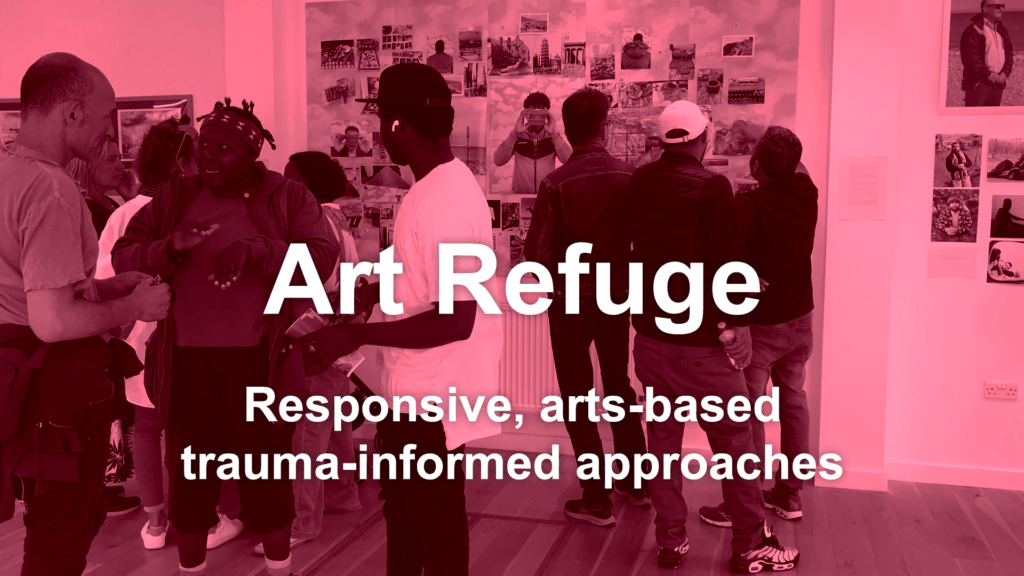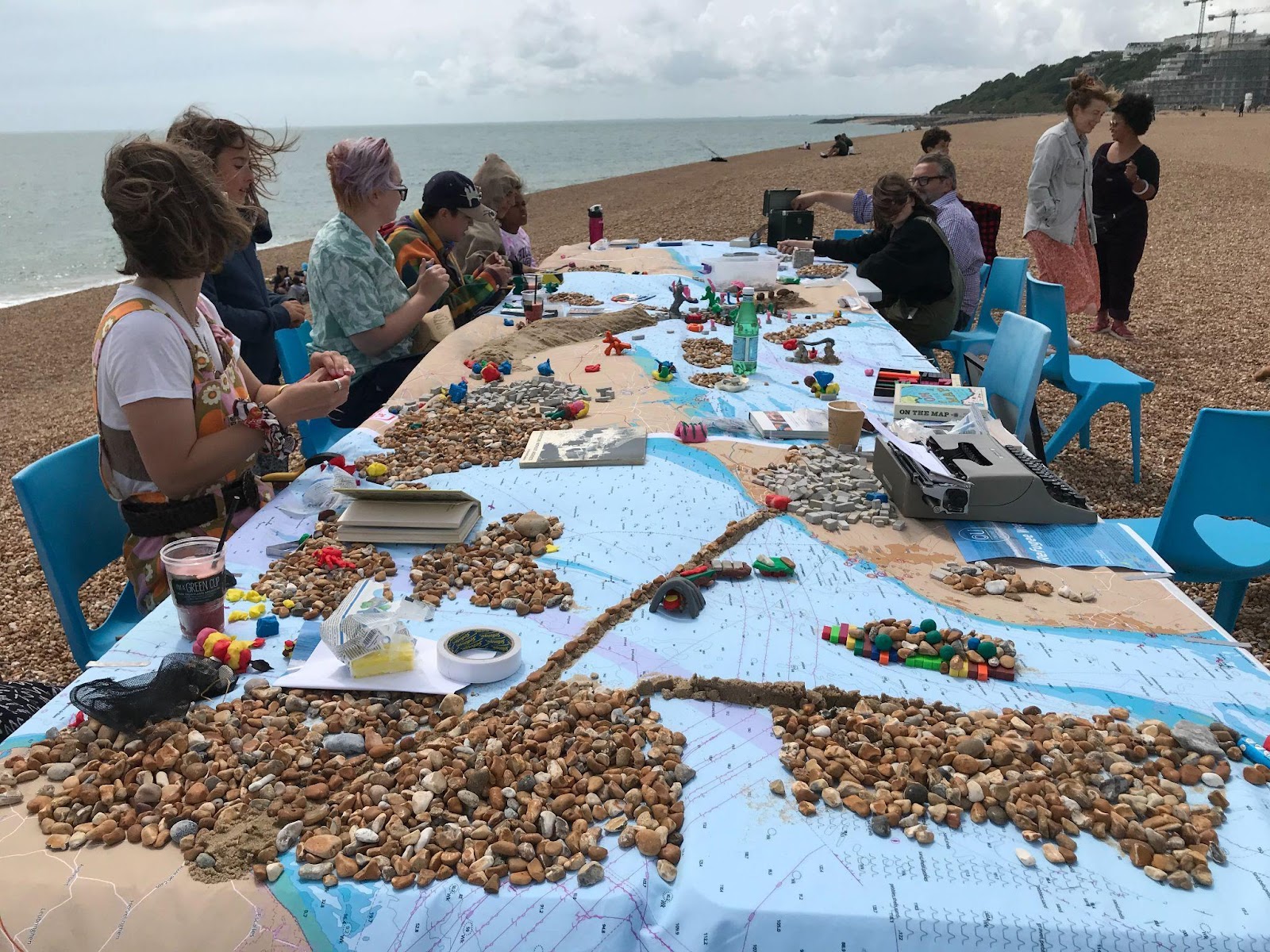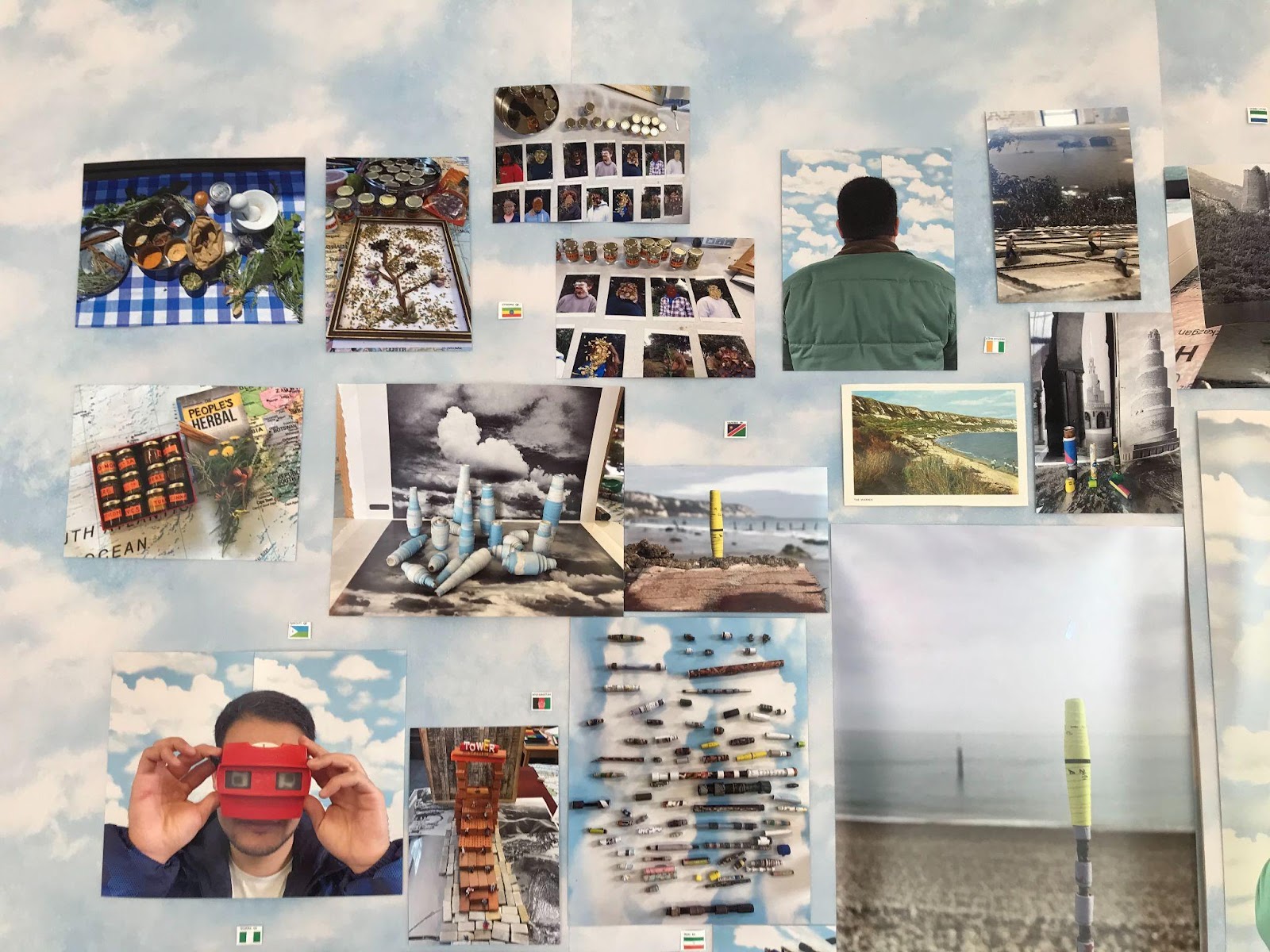
About Art Refuge
Art Refuge is a UK registered charity (no. 1114353) that uses socially engaged art and art therapy to support the mental health and well-being of people displaced due to conflict, persecution, poverty and climate emergency, both in the UK and internationally. The work is led by a freelance team of Health and Care Professions Council (HCPC)-registered art therapists and artists, including artists with lived experiences of displacement. In addition to longitudinal programmes in northern France and southern England, the charity delivers tailor-made training for frontline workers and takes part in short-term projects, exhibitions, collaborations with local and national non-governmental organisations (NGOs) and cultural institutions, academic activity and research.
About the project
From 2021-23/24 Art Refuge offered arts-based mental health and wellbeing support to men aged 18 and over housed in Napier Barracks, East Kent, through regular psychosocial support using The Community Table, alongside further socially engaged art activity and engagement with local and national NGOs and cultural institutions. Most of the men participating came from countries across the Middle East, central Asia, and north and east Africa.

Project context
On a former military site on the edge of Folkestone, Napier Barracks opened in September 2020 as a Home Office accommodation setting for adult men seeking asylum in the UK who stay for 60-90 days before being moved to dispersal accommodation across the country. It was met by far-right activity; local and national media interest; and court cases due to a large outbreak of Covid-19 and conditions deemed unsuitable, such as by Public Health England.
As in other areas of the UK asylum system, those housed at Napier have faced significant barriers to accessing relevant mental health and other support within already stretched local, statutory and community services. They also face discrimination and inequality, their lives often on hold while they wait for their claims to be processed. The inevitable impact on mental health has been further exacerbated by the Hostile Environment, inflammatory language and ongoing changes in government policy.
Goals
Art Refuge uses responsive, arts-based trauma-informed approaches, at the heart of which is The Community Table, an innovative model of open access, group-based, mental health support for people on the move and in the UK asylum system who are often isolated, marginalised and living in hostile, precarious situations. It also develops socially engaged art projects with the specific aim of building bridges into communities.
In early 2021, Art Refuge started offering weekly arts-based psychosocial support on and off the Napier site, which developed across 3 years with smaller projects woven into the longitudinal practice. Such work took time and patience, and involved a mix of artists, art therapists and practitioners from other fields. Community building and collaboration were at the heart of the project, with connections with both local and national partners, funders and cultural institutions adding huge value.
Participatory considerations and practices
The organisation uses art as a way of connecting people who are displaced and in the UK asylum system in the here-and-now to help build resilience, increase agency, and support creative thinking, while carefully protecting their anonymity. Inviting other frontline staff, local artists and visitors to participate at The Community Table and associated activity made way for dialogue, sharing of knowledge, skills and capacity that was both open and convivial. In this way, the project offered a unique opportunity to strengthen connections through intersections of differences and similarities, further increasing and strengthening links with other services.
Lived experience of displacement played a crucial role as a frontline project. Along with core artists in its team with lived experience of displacement (our team currently includes artists from Eritrea, Kurdistan, Afghanistan and Iran), diversity of age, experience, culture, gender played a central to The Community Table model and allowed for cross-fertilisation of ideas and learning. It continued connection beyond the sessions by sharing anonymised images on social media – see Instagram @artrefuge_ where our broad following includes current and former participants, developing a lively, online community.
Project outcomes
Cultural exchange and engagement included:
- The Community Table in Napier Barracks and Napier Drop-In with workers from across the NGOs joining, alongside local spoken word poet Josie Carter and artist Aida Silvestri, both from Origins Untold.
- “HOST – Hundreds of Small Tails” – an exhibition for Folkestone Fringe in which small plasticine animals made in Calais and Folkestone were ‘hosted’ by shops, galleries and other public venues, curated by Aida Silvestri.
- Refugee Week 2022 theme of Healing: The Community Table on Folkestone Beach, funded with help from Counterpoints Arts’ Kent border fund, in partnership with Origins Untold. Table transferred to the Brewery Tap UCA Project Space (the University for the Creative Arts’ research hub), exhibition, and project space in Folkestone’s Creative Quarter) alongside exhibition including images from The Community Table and joined by several men (participants/artists) from the camp. Exhibition transferred to a room inside the camp next to Migrant Help and accessible to everyone on site.
- King’s College, London University: collaboration with classicist James Webster-Corker on a project concerning ancient and modern writings on persecution, and the relationship between memory and experience. Ethics approval led to September 2022 workshops in Folkestone and Calais and final exhibition: Arcade Gallery, Bush House, the Strand, March 2023.
- 2023: partner on ‘Living Seams’ – “On Exile and Displacement in East Kent 2000-2021” with Atelier Armonico, Heritage Lottery funded. It included workshops and exhibitions: Woodpecker Court, Napier Barracks, Napier Drop-In; Morley College; Kent Mining Museum; JW3. Following dance workshops led by two choreographers and five dancers, the project culminated in a performance at Quarterhouse, Folkestone, of Kurt Weill’s ballet/opera Zaubernacht set in a refugee camp and at sea, attended by men from Napier, volunteers and local organisations.

Reflections
Community engagement and relationship building lie at the heart of the organisation’s work which supports a shared endeavour with its partners in contingency asylum accommodation and day centre spaces, thus improving resilience within the local communities where its projects take place. Direct feedback from men housed in Napier included that they felt valued, less isolated, more hopeful, and better able to cope and access other services, including mental health support. There was also interest in the Community Table model locally in Kent, but also nationally and internationally, from the NHS to art colleges, cultural institutions, local theatre projects, journalists and universities, including training requests on arts-based tools and trauma-informed practice.
Storytelling and objects: Art materials and other resources were carefully selected and adapted for this setting, responding to the culture, language, experience, skills, potential and richness of those attending e.g. through world and local maps; engineered miniature clay bricks; typewriters; photography; film; animation; postcards; drawing; plasticine; sound. Anecdotes: Emanuela Maggioli, experimental psychologist/researcher from UCL, joined us on and off-site exploring spices and Smells from Home. Using a past Folkestone Triennial catalogue, a young man built his version of the Hawksmoor-inspired beach hut by Argentinian artist Pablo Bronstein, having noticed it himself on his recent seafront walk.
Cultural exchange and working inside/outside of institutional structures: Integral to our practice is bringing cultural opportunities and institutions into the spaces where people are living and offering opportunities to bridge into the institutions themselves. With Living Seams, dance steps from the men were incorporated into the final performance, while one man from Afghanistan explained that dance performances were banned under the Taliban, and this was his first opportunity to see live dance, and the dancers/choreographers spoke about how profound they had found the workshops, and impetus to develop them further.
Looking to the future
In 2024, following reduced numbers in the Barracks, and greater community engagement and shifts in local perspectives, Art Refuge reduced its presence while the success of this project enabled our transition to the larger, complex setting of Wethersfield Asylum Centre (a former RAF site) in rural Essex where around 600 men are housed at the time of writing, and it has started to connect with local cultural institutions, such as Gainsborough House in Sudbury. Core funding for this type of much needed frontline work delivered by small NGOs and charities such as Art Refuge is an ongoing challenge, and urgently needed to support such longitudinal programmes and cross-fertilisation of projects and ideas into the GLAM sector.
Additional notes
The organisation looks forward to contributing to well-funded, safe and imaginative art-based spaces across the UK that support the mental health and well-being of people in the asylum system. It also looks forward to an end to the hostile environment, with government policy changes to include safe legal routes, and a more compassionate environment overall for asylum seekers and refugees.
Learn more
Usiskin, M. Lloyd, B. Press, N. (2020) Temporary, Portable and Virtual – making galleries on the France-UK border at Calais. In Art Therapy in Museums and Galleries. Jessica Kingsley Publishers.